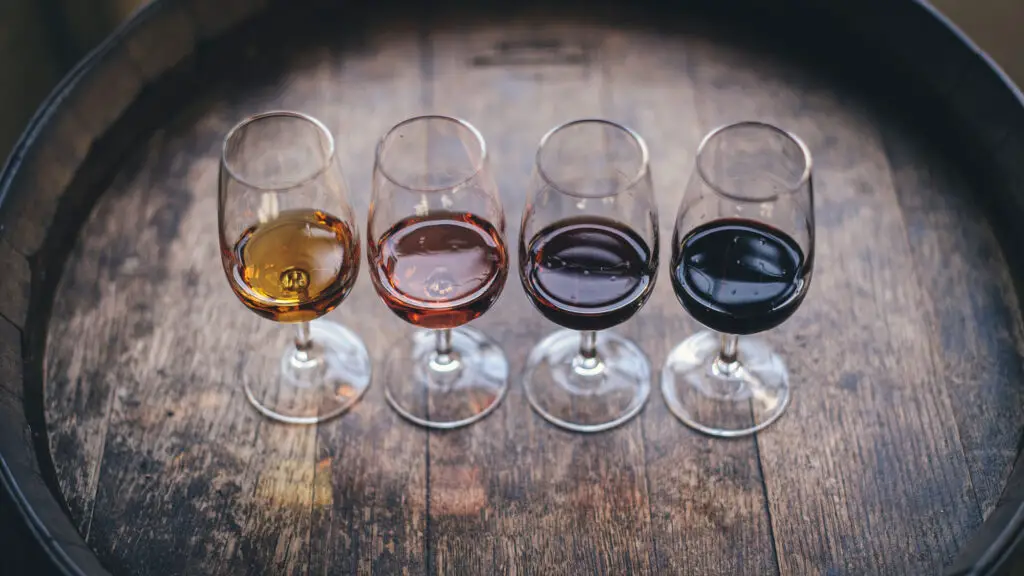Wine may be the most aromatic alcoholic drink on the planet. It has an extensive profile and various types of notes on the palette. The smell of wine depends on the grape variety, tannins, wine yeast, and the environment for fermenting and aging. Anyway, all these processes seem very pleasant and are supposed to transfer wine’s delicate and beautiful aromas. So what should you do when your wine smells like burnt rubber?
The stinky smell of burnt rubber in wine is often the result of sulfite compounds in the wine. Mercaptans are responsible for the burnt rubber smell present in some wines, while hydrogen sulfide (H2S) is the main culprit for the stinky, rotten-egg, or rotten-sewer smells.
Let us move a bit from this stinky topic and enjoy real and pleasing wine aromas. Then we will return to why wine smells like burnt rubber.
Aromas of Wine
Wine is one of the rarest things that is worth smelling on the earth. Overall, the smell of wine in a glass is the aroma of a wine. There are floral, citrus, fruity, vegetal, earthy, or any number of familiar scents of wine, depending on the winemaking process implemented the grape variety used, and the wine’s storage conditions.
Author Note: Smelling the wine is not just a part of the typical process. If you don’t smell the wine, you cannot feel the real taste of it. The fact is that we get 90% of the taste by smelling the wine.
We differentiate the sheer variety of flavors that are offered in a single sip by smelling it.
Meanwhile, the tongue is limited to sensing only salty, sweet, bitter, and sour.
You will need to improve the nose to pick up the flavor scents and the tongue to discern the tastes and textures.
Fruity Aromas

This category divides into subcategories as well. Let’s go through the different fruity aromas and some examples.
Citrus Aromas
- Lemon – acidified whites
- Lime – Australian Riesling
- Grapefruit – English wine, Scheurebe
- Orange – Marsala, sweet Italians
Tropical Fruits
- Pineapple – cool-fermented whites
- Melon – Mâcon Blanc
- Banana (can you imagine?) – Beaujolais
- Lychee – Gewürztraminer
Fruits with Stones
- Peach – eastern European whites
- Apricot – Viognier/Condrieu
- Apple – young Chardonnay
- Pear – Piedmont whites
- Black cherry – mature Pinot Noir
Berries
Berry flavors are our favorites. Here are some of them;
- Mulberry – Shiraz
- Blackberry – North Rhône
- Raspberry – young Pinot Noir
- Strawberry – red Rioja
- Blackcurrant – Cabernet Sauvignon
- Gooseberry – Sauvignon Blanc
- Grape – Muscat
The primary and prominent aromas are the fruit aromas, and they are the dominants. Violets, rose, chamomile, green apple, citrus, black and red berries would fall under the primary aroma category. This is very natural, by the way, as wine is made from fruits.
Dried fruits are also widespread notes that you meet when you slide your nose over the wine glass. These aromas are also famous as fruity-floral ones. They allow us to distinguish different wines and predict their age.
Vegetative Aromas
Vegetal wines describe the wine’s aroma and flavors that have stressed veggies. Those flavors are most likely proof of unripe grapes used to make the wine. Some critics don’t like such aromas in wine, and they think that the grapes that make wine should ripen grapes to make a glass of good wine.
Author Note: But some of them believe that vegetative aromas are more fresh and green. However, in some wines, a subtle vegetable smell is pleasant and adds complexity – these subtle vegetal characteristics are usually called herbaceous.
So, vegetative wine aromas also fall under these subcategories;
Fresh Aromas
- Cut green grass – Sauvignon, underripe grapes
- Nettles – Sauvignon
- Green pepper – less than ripe Cabernet
- Eucalyptus – ripe Cabernet
- Mint – New World Cabernet
- Geranium leaves – sorbic acid
- Currant leaves – Cabernet Sauvignon, Sauvignon Blanc
Dried Aromas
- Tobacco – Châteauneuf du Pape
- Straw – Chenin Blanc
- Tea – young port
Wooden Aromas
Wooden aromas are unavoidable as all the wine types are aged in wooden barrels. These aromas differ according to the wood type the barrel was made of.
The most used wood of all is oak, and the best barrels are made from it. So it gives the following notes to the aging wine; coffee, smoky, burnt toast, sometimes vanilla and cedar.
Spicy Aromas

Wine gets its flavors during the fermentation and aging process, so the yeast and wooden barrels are guilty of the spicy notes you will find in some wines.
- Spicy – Alsace whites, Southern Rhône reds
- Licorice – dense red wines, mostly Syrah
- Black pepper – Syrah
- Vanilla – American oak
- Ginger, aniseed, cloves
We can go on forever talking about other aromas like caramel, earthy, leather, floral, oxidative, and more. But, time to get to the sour aromas wine can contain.
Wine Faults
There are many ways to tell if your wine has gone bad or not; we have talked about them in our blog too. But now we are going to see why it goes bad and why wine can smell like burnt rubber.
The wine taste profile is vibrant, so at first, you may not understand that it should be the smell/taste or that it is already spoiled. The good part is that almost all the wine faults are not harmful. They just taste unpleasant. So when you find those characteristics we are going to list below, you had better make vinegar out of it.
To cut it short, wine can smell/taste like burnt rubber when it is spoiled. Here are cases when you know it is spoiled.
Oxidized Wine
Oxidation is the most common wine fault, contamination caused by too much oxygen exposure. You know when the wine oxidized when you see it lose its brightness both in taste and color. Red wines turn into brown, sometimes orange colors.
White wines also turn a brownish color, but they are more sustainable than reds as the tannin level in reds is higher. You cannot fix oxidized wine, but you can always save it to cook or make DIY vinegar. Note: wines can be oxidized at home. You can try that.
Trichloroanisole (TCA)
Easy processes are done, now this is a chemical issue. TCA, also known as cork taint, is a chemical containment that may have appeared in your bottle, most likely by the cork. The bad news is that it can also drop from the barrels, and it means that entire batches are spoiled.
This type of spoiled wine smells wet like a newspaper or a wet dog. Those flavors became dominant, so forget about the lovely fruity aromas, they will be at a minimum. You cannot fix this too, but you can always return the bottle.
Sulfur Compounds
Sulfur is a must ingredient that is added in small amounts to almost all wine to stabilize it. That’s why it is a complicated topic for wine. It would help if you always were very careful with it.
Dihydrogen sulfide (H2S) is another sulfur compound found in wine. It is a naturally transpiring bi-product when winemakers start fermentation.
Sulfur compounds smell smoky like burnt rubber. It also adds aromas like struck match or cooked cabbage. The majority of those smells dissolve in about 15–20 minutes after opening a bottle. This is why it is important to air or decant your wines. They also say you can put silver in the wine and the issue may be fixed.
Secondary Fermentation
Author Note: This is bubbles in a non-sparkling wine. When residual sugar is corked with the wine, it results in re-fermentation. This issue is easy to distinguish as you will not accept bubbles in your Pinot Noir.
You can also listen to the fizzing sound. Unfortunately, you can not fix this, but you can do in-depth research to ensure why the bubbles are really not needed.
Heat Hate

This means your wine hated the heat, and you left it in a warm place. You may have left the wine bottles next to your stove and cooked all of them. Or forget to move them into a colder room on a hot summer day.
This is a widespread case. The wine turns brownish and smells jammy sweet. Of course, you cannot fix it, but you can save it for making sweet dessert cocktails.
UV Light Damage
Alternatively, this is called a light strike. This happens when you leave the bottle under the sun or next to the window. The smell is like that of a wet wool sweater. You cannot fix this problem but you can make sure to avoid making the same mistake next time.
Bacterial Taint
If you have added yeast to the wine, you have invited the microbes in too. You may smell various scents, but it is hard to tell what you smell precisely. It gives you the feeling of an oversalted dish. It feels wrong. Maybe the nearest smell compared to the others is a mousy smell.
You cannot fix this case too. Just throw this wine away—Time’s up.
Goodbye Thoughts
The best thing about wine is that it is not harmful in any form. And you can use it in different ways, if not to drink it. You can cook, you can turn it into vinegar, and even you can drink it if you don’t mind the new tastes. But, it is a pity that it lost its beautiful aromas.
So if you can avoid spoiling it, please do. Anyway, we prefer fresh and delicious wines to drink and recommend the same to you. So keep an eye out for these spoiling signs! We hope you enjoyed this article on why wine smells like burnt rubber sometimes.
To living a full-bodied life,
Wesley

